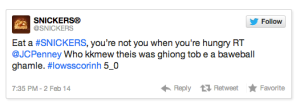For class this week, we were asked to read this article by the Pew Center about mapping Twitter networks. An interesting read, this article identifies 6 different networks that conversations are taking place in.
Polarized Crowds. These are described as two large clusters that have little interaction. The article uses the example of politics and in class we talked about sports teams. I think this could even apply to noncompetitive situations also though. Take two universities for example. Students on Twitter are highly connected to others from their campus, but have few ties to other universities. These clusters stay separated, despite the lack of competition.
Tight Crowds. This is exactly what it sounds like: a very interconnected group of people. This forms from certain groups or during conferences, especially if everyone is using a certain hashtag. My best example is the Big Omaha conference, put on by Silicon Prairie News. Even though I was only a volunteer, an app (Spun) allowed everyone at the conference to see how we were connected to each other. And trust me when I saw we were literally all connected.
Brand Clusters. I love being a part of brand clusters. These are when different types of people are all following the same brand. They may not ever connect without that similar passion for the brand. I follow Sevenly on Twitter, and they are fantastic about interacting with their followers. Thanks to them, I’ve found more people to follow on Twitter that share the same values that they do as a brand.
Community Clusters. I think of these as very location based clusters. The example from the article is different news sources, because each has it’s own small following. I follow my local news channels and police department on Twitter, but I could care less about stations in Seattle. While these are smaller clusters, they contain a more geo-targeted audience.
Broadcast Network. This is similar to the Community Clusters, but this difference is that the Broadcast Network include followers that simply repeat what major news sources are saying. They help to broadcast the information. In my mind, these people are journalists that will share their own articles or other’s without adding new content.
Support Network. The final group, I find this to be very similar to the Brand Clusters. I think the difference is that while Twitter accounts with the sole purpose of support may not have a high number of followers, a wide variety of people will still Tweet at them. These are almost like “emergency” Twitter accounts, that are always connecting with new people as problems come up.
The article ends with a short section on why mapping is important. It explains that mapping helps to see trends and is like an “aerial photograph of a crowd.” That’s great and all, but what about pointing out how useful this can be for advertising? Targeting your audience? Specializing your message to appeal to a certain group of people?
That’s where I see the usefulness of mapping social media. No matter what you’re doing on social media, your message should be directed at an audience and knowing their Twitter patterns can help “locate” them. It can be hard to sift through the noise on the Twitterverse, but mapping is one way to help clear the content.



